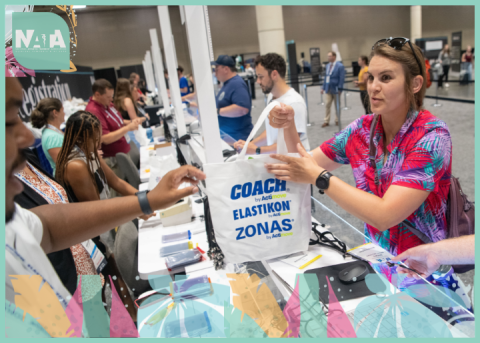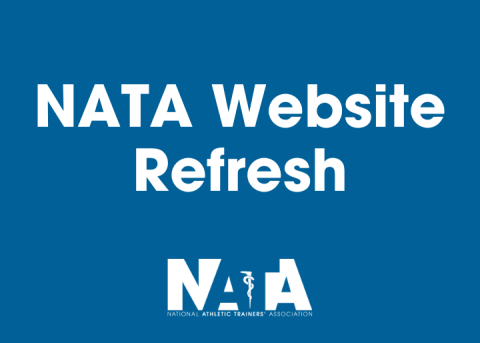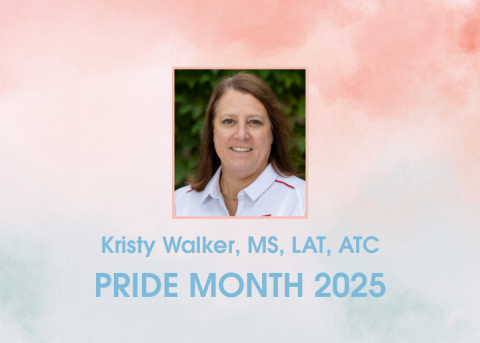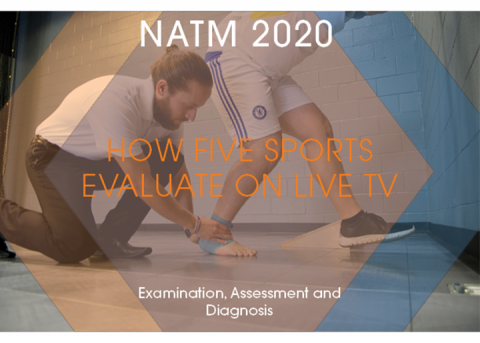
Editor’s note: In honor of National Athletic Training Month, NATA is conducting a twice-weekly blog series throughout March that showcases how ATs the five domains of athletic training to improve the health and well-being and their patients. This blog post highlights domain two, Examination, Assessment and Diagnosis, and how members are embodying this year’s NATM theme, “ATs Impact Health Care Through Action.”
Evaluating a player can be a high-pressure situation, especially with coaches and officials wondering about the status of the player and wanting to resume play as quickly as possible. Evaluating a player can have even more pressure when it’s on live TV. For professional sports athletic trainers, that’s just another part of their job: the roar of the crowd, knowing all eyes are on them both inside and outside of the building. It can be a challenge but one ATs have to master as health care professionals.
So how exactly does the live TV aspect affect evaluating? We spoke with the presidents of the five professional sports societies: James Collins, MA, ATC, past president of the Professional Football Athletic Trainers Society and director of football and medical services for the Los Angeles Chargers; Chris Kingsley, MS, ATC, president of the Professional Hockey Athletic Trainers Society and head athletic trainer of the Los Angeles Kings Hockey Club; Sean Kupiec, MA, ATC, CSCS, president of the Professional Soccer Athletic Trainers’ Society and head athletic trainer for the Los Angeles Football Club; Aaron Nelson, MS, ATC, AT, CES, president of the National Basketball Athletic Trainers Association and vice president of player care and performance for the New Orleans Pelicans; and Ron Porterfield, ATC, director of player health for the Los Angeles Dodgers and president of the Professional Baseball Athletic Trainers Society.
What is it like evaluating during a live event? Do you get nervous?
James Collins: I’m not nervous. You’re aware of everything going on, but it really doesn’t affect you because you’re locked on the player and injury and making sure you’re doing the best job possible for the player. Once the game starts, I don’t think about the crowd. It’s almost like nobody’s there.
Chris Kingsley: I’m never nervous evaluating a player. You must always remain calm in all situations. I am there to evaluate the player and their particular injury. I’m gathering information that helps determine the next steps taken in regard to our particular protocols we have in place. We don’t have the pressure to hurry just because we are on TV.
Sean Kupiec: The more you are accustomed to the environment, the less of a distraction it becomes. As long as you remain focused on your task, the surroundings do not make a particular difference. I am not nervous.
Aaron Nelson: I think that you don’t think about the TV side of things. The first time doing it, I was nervous because I don’t want to mess up. After a couple of times, I stopped thinking about it.
Ron Porterfield: It can be a little nerve wracking, especially the first few times that you do it in front of a large crowd. It’s a bigger stage, if you will. Last thing you want to do is look incompetent in front of people or on TV, trip or fall or something crazy happen to you. What I always tried to do, regardless of the scene – whether in small crowd or World Series – was to just stay calm and concentrate on the task at hand, which is taking care of the athlete.
Is it a different type of pressure being on TV rather than in a private clinic?
James Collins: The only pressure you may feel is trying to make a safe decision as fast as possible. Once you and the physician are doing an evaluation, you’re thinking about whether you’re going into the locker room or sideline. Once you’re at the sideline, the coach wants to know how soon the player will be back in the game, and you may not have that information right away.
Chris Kingsley: When evaluating on TV, you do quick but thorough assessment to determine the severity of the situation. In our sport, the players’ equipment is a limiting factor in regard to evaluations. Once the player is removed from the ice surface and brought to the dressing room or athletic training room, the equipment is removed, and a more comprehensive evaluation is performed. If an emergency situation occurs, protocols are in place to remove players’ equipment if necessary.
Sean Kupiec: Sure, but again making sure that you are focusing on the most appropriate management for the situation and in a timely manner helps to take the edge off. The elements of fans, officials, players, coaches and the actual circumstances of the game all add to the potential challenges.
Aaron Nelson: I think it depends on whether it’s a severe injury. You want to make sure the cameras aren’t on it if it’s severe. Usually, the coaches come and players surround the situation to block, if needed. We don’t want anything that could be grotesque to air, if possible, because it will be replayed. From a pressure standpoint, no. Our job is to do a sweep evaluation.
Ron Porterfield: Not really. You’re making more of an experienced educational decision. Going out there for a lot of young ATs is may be a shock because there are a lot of individuals that don’t even like getting up to speak in front of a large crowd. Once you do it a few times, it becomes second nature.
Do you have to evaluate more quickly?
James Collins: Not at all. The key for us as medical providers is to take care of a player as we would in practice or if they walked into clinic. Evaluate them just as you would inside when there wasn’t a crowd because the primary reason is to take care of player. The evaluation doesn’t change. It may seem quick, but with experience and other ATs and physicians involved, you see common injuries.
Chris Kingsley: When we are on the ice with an injured player, our job is to assess the situation and determine the next course of action. If the injury is serious or potentially life threatening, we active our emergency action plan. If we determine we can get the player off the ice safely, we do so in the appropriate manner.
Sean Kupiec: I would say that during a live event it is definitely a quicker, direct and abbreviated triage scenario. The clock doesn’t stop when we go on the field, so it’s running time, and the officials add time. I try to control the scene as soon as possible; whether by placing my water bottles away from the area while running out or by clearing people away as fast as I can. Officials are standing over us and add stress because they try to hurry us off the field, and we’ve got ear pieces with the bench asking what the status is. The important thing is getting to the scene and taking the appropriate steps to manage the situation.
Aaron Nelson: Yeah, I’m obviously watching the game mechanism and evaluate how severe it is, and if they can stay on the court or need to come out. If they come out, I’ll do further evaluations. If it’s more severe than that, we’ll go to locker room and do more thorough evaluation.
Ron Porterfield: My first year I felt pressured. The umpires are usually coming out there to speed things up a little but at the same time respecting the time it might need to make a decision. Two minutes can feel like an hour when eyes are all on you. When doing a manual exam on field, there is always the thought that MLB can be videotaping and watching all you do. This, of course, can be for a good learning process. I try to do all I can to keep my composure and try not to get too caught up in the moment; I try to take a deep breath and take my time. Just like a player, you can get a little anxious out there. We make a decision as quickly and prudently as possible.
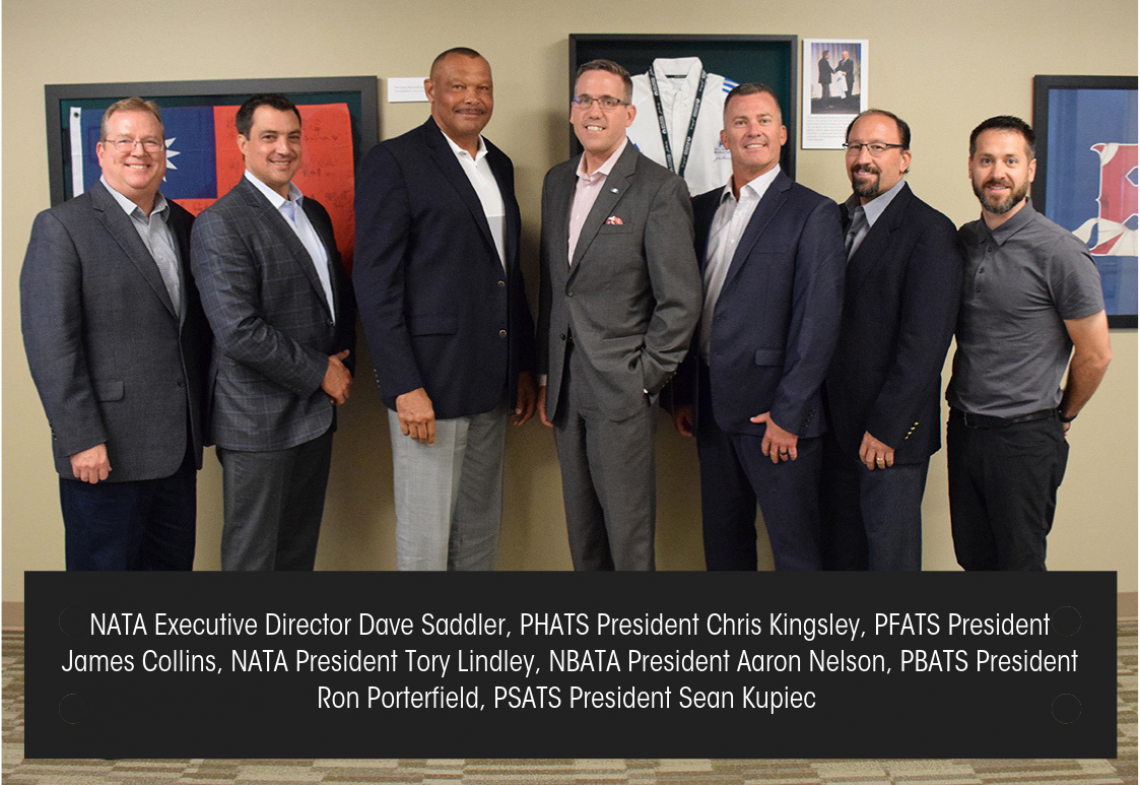
Do you have to follow any special rules?
James Collins: No special rules, but we are out in the middle of the field with cameras on. On the sideline, there is a camera that can see us, hence why we introduced the medical tent and now can have privacy, which helps quite a bit because the player relaxes and gives better information and better feedback on their injury and we can make better and quicker decisions because of that.
Chris Kingsley: There are no rules to evaluating an athlete on TV. You always have the best interest of the athlete in mind. Their health and safety are the priority.
Sean Kupiec: There’s nothing written or special. Priority one is we want to make sure we are providing the appropriate care. Secondary to that is being sensitive to everyone in attendance and watching if possible.
Aaron Nelson: No. It’s about the safety of the athlete. If a guy goes down, we can’t go on the court without a timeout otherwise it’s a technical foul. If it’s a head injury or concussion, then officials call timeout, and we get out on court as quickly as possible to do evaluations. But once we are out there, there are no specific rules.
Ron Porterfield: I am sure there are written and unwritten rules; however, it is again about the care of the athlete, making a good decision to ensure safety and care. The player can get very dramatic, so helping to keep them calm and address the injury presented. The ability to not panic and attempt to either allow the player to remain in the game or remove the player from the field under his own power if applicable is what I strive for. I will always use cautious judgement and error on the side of caution.
What do you do during a serious injury?
James Collins: We have to really not think about the live TV part of it. We have to think about what is your job. As far as medical staff, our job is to take care of the player. If there is blood or a fracture. We keep the player calm and tell them we have everything under control. We go about in a systematic way to not get the player or anyone else excited to create a scene or chaos.
Chris Kingsley: Regardless of being on live TV, I always remain calm in any situation no matter how serious it may be. The athletes we work with trust us and the procedures we have in place for all emergency situations. We have the necessary physicians and support staff in place at all games. We must always stay composed so our athletes remain calm and assured they are being well taken care of.
Sean Kupiec: I’m already wearing gloves at the start of the game, so I’m ready to go. We have physicians present at each game that we may call onto the field with us if needed, or if it’s clear and obvious they are needed, they enter with us as well. With a fracture situation, if there’s gross deformity, we may use a towel, if appropriate, to cover the wound site. In those situations, players on the field can become incredibly emotional as well. It can be pretty dramatic, and I try to reduce as much shock and visual stimulus to people. It’s important not to get wrapped up in the environment (crowd, players, officials and bench) and implement the appropriate management strategy for the situation that we have practiced as a sports medicine team.
Aaron Nelson: Blood is a 30-second timeout, depending on severity of the laceration or abrasion, so the pressure is on from that standpoint. With a dislocation, the main goal is to get the player out of there quickly and assess. It happened a couple years ago in Phoenix with a dislocated ankle. It was a grotesque injury, and we had to cover it up. You don’t like to see them, but it’s part of the sport. It’s a lot more, I wouldn’t say pressure, but you want to take care of it quickly – particularly when people are watching.
Ron Porterfield: During a serious injury, the most important thing for me is to not get caught without help. I will at least activate EMT’s so that I know during my initial evaluation I can relax knowing that I have help on the way. I assess the situation, stay in control until I have a physician or EMT that takes over the injury, then I do my best to assist them and in helping the athlete stay calm. Concentration on the situation is usually what takes precedence, and I really have not had much thought about what is going on around the situation. Adrenaline and care take over.
Any advice to athletic training students interested in this setting?
James Collins: Just stay true to yourself. Don’t let anyone or anything around you dictate how you take care of your player. You are to watch out for their safety, health and wellness, so stay true to what profession requires, and you will do just fine. Don’t let coaches, TV or players dictate how you handle an injury. If you trust your abilities, everything will be perfect.
Chris Kingsley: Be confident and trust their skills and preparation. Being on TV doesn’t change the job we are there to do. I will always remember my first game in the NHL. I think I rehearsed all possible scenarios in my head prior to the game. The best advice given to me was to stay calm, be confident in your skill set and enjoy the moment.
Sean Kupiec: The more exposed to the environment, the more comfortable you are. Attention to detail and situational awareness is key, and if you have those two concepts down, you are better prepared for any scenario. Internships are a great way to gain experience. Getting familiar with the environment will make you naturally better able to deal with the situation. If interested in the professional setting, I would encourage every student to apply for internships. I feel more prepared to do my job because I got more experience in this arena. I cannot overstate how valuable it is. If you know a setting you want to be in, get experience in that setting. Seek out opportunities to get involved with collegiate and/or professional teams.
Aaron Nelson: The preparation aspect. If you’re young and want to get in, try a high school setting with less people watching than collegiate, which is less than pro, and then go pro. Education and teaching is important, so do as much to prep when you’re young, whether as an assistant or intern, to prepare yourself. In between, when you start and get that role, there are probably lots of opportunities to be put in a position where you’ll get to evaluate. It might be during a practice or preseason or summer games, but get used to what you do.
Ron Porterfield: Nobody is going to hear your conversation out there on the field other than maybe the individual player, coach or umpire. Take that into reality. If your problem is to be in front of crowds, go speak publically in front of people to get accustomed in front of people and not be afraid. Give a talk to the colleagues, so that’s in front of 20 to 25 people versus 25,000 or 35,000. I don’t think there’s a class that will teach you that. Visualize situations and scenarios so when they happen to you it can make for an easier transition of what to do. Stay calm and address the situation at hand. Don’t forget that you were trained to do this.
Anything else you’d like to add?
James Collins: Another key to working in front of hundreds and thousands of fans, the medical staff needs to be a team and practice emergency action plans. Get with the team physician, and talk about how to handle any injury. Have a relationship with everyone on medical staff so when the time comes to take care of injury, it’s easy because you understand each other. You have to work as a team, and everyone has to be on the same page. There will always be circumstances you don’t think of, but if you stay calm and true to yourself and keep in mind player health and safety comes first, things will work out pretty good.
Sean Kupiec: The athletic training world, especially in high level athletics, is very small. Take pride in what you do, and network. Those will help tremendously in having you get to where you would like to go. Add to your tool belt and bag of tricks; diversify the skills you have. That will not only set you apart from individuals but makes you infinitely more prepared to deal with a large variety of situations. Become great at what you do. Don’t expect to do the bare minimum because this isn’t the career for you, especially in professional sports because you sacrifice a lot personally to provide what the players need.
Aaron Nelson: Repetition, and it’s hard because some people are more nervous than others. It’s just about finding the right resources, whether someone on staff or professionally, to get over that fear of live TV. When you’re put in that position, you need to be able to go and evaluate quickly. Anyone with a fear of being in the eye of the public or under the microscope really needs to figure out all the things they can do to be responsible.
Ron Porterfield: The big thing is to trust your gut feeling to make the decision and if you’re in doubt, remove the athlete. No matter how much an athlete fights you or is mad at you, their parents will be happy with the decision you make ultimately.
Continuing Education Opportunities
Log into the NATA Professional Development Center, and search for the following courses that relate to domain two, Examination, Assessment and Diagnosis. You can also explore upcoming webinars to earn additional CEUs within the PDC.
A Systematic Approach for Return to Sport Testing and Management Following Lower Extremity Injury
ACL Injury Prevention


